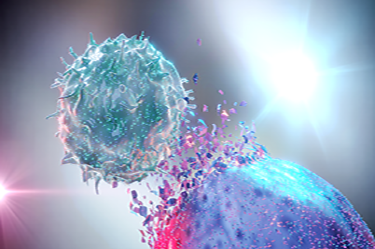Immunotherapies have offered new hope to patients that haven’t responded to traditional cancer treatments. While many of these breakthroughs have improved survival rates and patient outcomes, ongoing research is needed to improve safety profiles and optimize efficacy of existing treatments as well as develop additional novel immunotherapies in difficult-to-treat cancers.
Mouse models continue to serve a valuable role in pre-clinical immunotherapy research as humanized mice can recapitulate the human immune system and human tumors.
To better understand how certain models can help advance cancer research, we spoke to Hongmei Jiang, PhD, Senior Scientist on our GEMS R&D team where she customizes rodent models and designs genetically modified models for research studies.
“When our team works to support researchers on their cancer therapies, we first learn about the specific purpose of their study,” said Dr. Jiang. “Each model has its own benefits and limitations, and we can help them find the best match.”
She outlined the key models we have that support oncology research:
The B-NDG model [NOD.CB17-Prkdcscid IL2rgtm1/BcgenHsd] is a knockout mouse with an ultra-immunodeficient phenotype. Using CRISPR-Cas9 technology to delete the IL2rg gene, this model lacks functional receptors for IL-2, IL-4, IL-7, IL-9, IL-15, and IL-21, which results in the lack of functional NK cells. In addition, its Prkdc (protein kinase DNA-activated catalytic) null scid mutation is characterized by lacking mature T cells and B cells.
“The B-NDG model displays a deficiency in cytokine signaling and is very good for engrafting with human cancer cells or tissue,” explained Dr. Jiang. “These models are often used to develop PDX, CDX, and humanized models with hematopoietic stem cells (HSCs) or peripheral blood mononuclear cells (PBMCs). While the B-NDG model is invaluable for many types of in vivo studies, B-NDG mice engrafted with a human immune system lack functional NK cells due to low homology between the mouse and human IL-15 gene, an important factor in NK cell generation in HSC.”
The B-NDG hIL15 [NOD.CB17-PrkdcscidIl2rgtm1Il15tm1(IL15)/BcgenHsd], developed by Biocytogen, was created on the B-NDG background to express the human IL-15 cytokine, allowing the model to properly establish NK cells. This feature helps boost the development and survival of functional human NK cells in the context of immunodeficient mice engrafted with human cells.
“The B-NDG hIL15 is an extremely valuable tool for evaluating NK cell-based immunotherapies and their function in tumorigenesis,” said Dr. Jiang.
Finally, the B-NDG B2m Double Knockout Plus [NOD.CB17 PrkdcscidIl2rgtm1B2mtm1Fcgrttm1(B2m)/ BcgenHsd] offers another highly immunodeficient option with a Beta 2 microglobulin (B2m) null allele.
“B2m single-knockout animals demonstrate rapid antibody clearance, making them inadequate for antibody efficacy testing. To overcome this limitation, in the B-NDG B2m Double Knockout Plus model, the B2m gene is deleted, but its coding sequence is fused to the Fcgrt gene. We found that the novel double knockout strain prolongs antibody half-life and shows a general reduction in graft versus host disease (GvHD),” noted Dr. Jiang. “This model allows a longer treatment window for efficacy testing.”
Looking ahead to evaluate treatment options for patients
With an ongoing unmet need to develop safe and effective treatments for cancer patients, preclinical studies using sophisticated mouse models will continue to play a critical role in evaluating novel immunotherapies.
“Immunotherapies have become very promising treatment options,” said Dr. Jiang, “but there are still a lot of challenges to overcome as we know that different cancers have different characteristics. I’m proud that Inotiv can provide these very powerful tools to study and learn more about the immune system response to fighting cancer. The future is very exciting as the field expands.”
A brief overview of immunotherapies
The traditional cancer chemotherapies and radiation approaches can target rapidly dividing malignant cells but can also affect normal, healthy cells and produce a variety of toxic effects for patients. Furthermore, some patients may experience poor responses to anti-cancer agents, or their tumors may develop resistance to treatments.
For decades, researchers have studied how to enhance natural immune system functions to effectively target cancers and reduce treatment-associated toxicities. Personalized treatments through CAR T-cell therapies were some of the first options for patients to treat hematological cancers.
Monoclonal antibodies (mAbs) have also been approved as targeted drug therapies that mimic natural antibodies. These mAbs can recognize cancer cells to either block cell growth or trigger T-cell activation to destroy tumor cells by using checkpoint inhibitors, such as cytotoxic T lymphocyte antigen 4 (CTLA-4), programmed cell death-1 (PD-1) and its ligands (PD-L1 and PD-L2).
Natural killer (NK) cells serve as another avenue in cancer immunotherapy research as these cytotoxic immune cells can induce an immediate killing effect and even develop adaptive immunity.
Beyond mAbs, checkpoint inhibitors and NK cells, the immunotherapy field continues to evolve in several areas to examine the use of cytokines, dendritic cells, and peptide vaccines to create anti-cancer responses.


